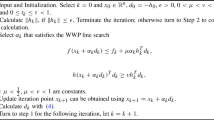Abstract
We introduce a novel technique for Magnetic Resonance Image (MRI) restoration, using a physical model (spin equation) and corresponding basis images. We determine the basis images (proton density and nuclear relaxation times) from the MRI data and use them to obtain excellent restorations.
Magnetic Resonance Images depend nonlinearly on proton density,ρ, two nuclear relaxation times,T 1 andT 2, and two control parameters, TE and TR. We model images a Markov random fields and introduce two maximuma posteriori (MAP) restorations; quadratic smoothing and a nonlinear technique. We also introduce a novel method of global optimization necessary for the nonlinear technique.
Similar content being viewed by others
References
C.J.G. Bakker and C.N. De Graff, “Precision in calculatedρ, T 1 andT 2 images as a function of data analysis method,”Magnetic Resonance Imaging 6:3–8, 1988.
G.L. Bilbro, W.E. Snyder, S.J. Garnier, and J.W. Gault, “Mean field annealing: A formalism for constructing GNC-like algorithms,”IEEE Transactions on Neural Networks 3(1):131–138, January 1992.
G.L. Bilbro, W.E. Snyder, and R.C. Mann, “Mean-field approximation minimizes relative entropy,”Journal of the Optical Society of America A 8(2):290–294, February 1991.
A. Blake and A. Zisserman,Visual Reconstruction The MIT Press, Cambridge, Mass., 1987.
S.A. Bobman, S.J. Riederer, J.N. Lee, S.A. Suddarth, H.Z. Wang, B.P. Drayer, and J.R. Macfall, “Cerebral magnetic resonance image synthesis,”American Journal of Neuroradiology 6:265–269, March/April 1985.
S.A. Bobman, S.J. Riederer, J.N. Lee, S.A. Suddarth, H.Z. Wang, and J.R. MacFall, “Synthesized MR images: Comparison with acquired images,”Radiology 155(3):731–738, 1985.
S.A. Bobman, S.J. Riederer, J.N. Lee, T. Tasciyan, F. Farzaneh, and H.Z. Wang, “Pulse sequence extrapolation with MR image synthesis,”Radiology 159:253–258, 1986.
R.K. Breger, F.W. Wehrli, H.C. Charles, J.R. MacFall, and V.M. Haughton, “Reproducibility of relaxation and spin-density parameters in phantoms and the human brain measured by MR imaging at 1.5 T,”Magnetic Resonance in Medicine 3:649–662, 1986.
T. Brosnan, G. Wright, D. Nishimura, Q. Cao, A. Macovski, and F.G. Sommer, “Noise reduction in magnetic resonance imaging,”Magnetic Resonance in Medicine 8:394–409, 1988.
D. Geman and S. Geman, “Stochastic relaxation, Gibbs distributions, and the Bayesian restoration of images,”IEEE Transactions on Pattern Analysis and Machine Intelligence PAMI-6(6):721–741, November 1984.
G. Gerig, O. Kuebler, R. Kikinis, and F.A. Jolesz, “Nonlinear anisotropic filtering of mri data,”IEEE Transactions on Medical Imaging, 1992.
F. Godtliebsen, “Noise reduction using markov random field,”Journal of Magnetic Resonance 92:102–114, 1991.
R. Graumann, H. Fischer, and A. Oppelt, “A new pulse sequence for determiningT 1 andT 2 simultaneously,”Medical Physics 13(5):644–647, September/October 1986.
Y.S. Han and W.E. Snyder, “Multi-variate MR image restoration using vector mean field annealing,” inSPIE Proceedings Volume 1768: Mathematical Methods in Medical Imaging, 1992, San Diego, California, July 1992. SPIE's 1992 International Symposium on Optical Applied Science and Engineering.
X. Hu, V. Johnson, W. Wong, and C. Chen, “Bayesian image processing in magnetic resonance imaging,”Magnetic Resonance Imaging 9:611–620, 1991.
M. Just, H.P. Higher, and P. Pfannenstiel, “Errors inT 1-determination using multislice technique and Gaussian slice profiles,”Magnetic Resonance Imaging 6:53–56, 1988.
J.B. Kneeland, A. Shimakawa, and F.W. Wehrli, “Effect of intersection spacing on MR image contrast and study time,”Radiology 158:819–822, 1986.
J.N. Lee and S.J. Riederer, “Optimum acquisition times of two spin echoes for MR image synthesis,”Magnetic Resonance in Medicine 3:634–638, 1986.
J.N. Lee, S.J. Riederer, S.A. Bobman, F. Farzaneh, and H.Z. Wang, “Instrumentation for rapid MR image synthesis,”Magnetic Resonance in Medicine 3:33–43, 1986.
J. Liu, A.O.K. Nieminen, and J.L. Koenig, “Calculation ofT 1,T 2, and proton spin density images in nuclear magnetic resonance imaging,”Journal of Magnetic Resonance 85:95–110, 1989.
S. Majumdar, H.D. Sostman, and J.R. MacFall, “Contrast and accuracy of relaxation time measurements in acquired and synthesized multislice magnetic resonance images,”Investigative Radiology 24(2):119–127, February 1989.
D.A. Ortendahl, N.M. Hylton, L. Kaufman, J.C. Watts, L.E. Crooks, C.M. Mills, and D.D. Stark, “Analytical tools for magnetic resonance imaging,”Radiology 153(2):479–488, 1984.
R.C. Wright, S.J. Riederer, J.N. Lee, F. Farzaneh, and J.B. De Castro, “High-speed techniques for estimatingT 1,T 2, and density images,”IEEE Transactions on Medical Imaging MI-6(2):165–168, June 1987.
Author information
Authors and Affiliations
Rights and permissions
About this article
Cite this article
Garnier, S.J., Bilbro, G.L., Gault, J.W. et al. Magnetic Resonance Image restoration. J Math Imaging Vis 5, 7–19 (1995). https://doi.org/10.1007/BF01250250
Issue Date:
DOI: https://doi.org/10.1007/BF01250250




